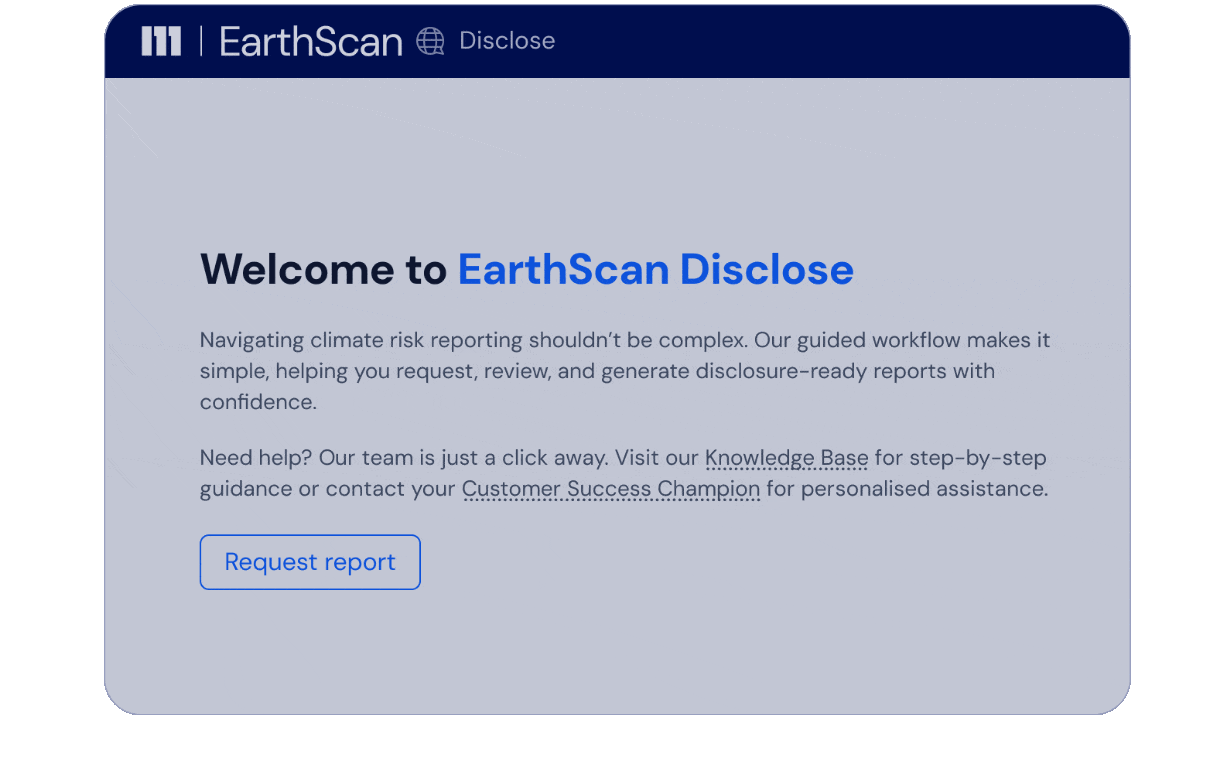Generate physical climate risk reports, instantly
Disclose helps you identify key climate hazards across your portfolio, quantify their potential effects, and translate them into financial risk. Instantly and at scale.
Align with IFRS S2, CSRD / ESRS E1, and related global climate disclosure mandates
Generate audit-ready reports in minutes
No internal modelling or formatting needed
Trusted by leading sustainability teams and consultancies
Backed by Microsoft Climate Innovation Fund







How Disclose works



Explore the hazards covered
Risk Category
EU Taxonomy
EU Taxonomy
ACUTE
Heat wave
CHRONIC
Heat stress
Changing temperature (air)
EU Taxonomy
ACUTE
Drought
EU Taxonomy
ACUTE
Coastal flooding
Fluvial flooding
Pluvial flooding
CHRONIC
Sea level rise
EU Taxonomy
ACUTE
Storm (blizzards)
Cyclone, hurricane and typhoon
Tornado
CHRONIC
Changing wind patterns
EU Taxonomy
ACUTE
Heavy precipitation
Hail
CHRONIC
Precipitation or hydrological variability
EU Taxonomy
ACUTE
Wildfire
''EarthScan is a straightforward climate risk analysis tool with a great UX environment. The team is also very supportive and makes sure your needs are met!''

Frequently asked questions
Right now, Disclose helps you report physical climate risk in line with two key reporting standards:
- ESRS E1, for CSRD reporting in the EU
- IFRS S2, which incorporates TCFD recommendations and is used in jurisdictions aligned with ISSB, like AASB S2 in Australia or California’s SB 261
Got a specific reporting standard or framework in mind? Let us know at sales@earth-scan.com
We cover the physical climate risk disclosure requirements within ESRS E1 (E1-9) and IFRS S2, supporting your Climate Risk and Opportunity assessment. This is often the most technical and time-consuming part of sustainability reporting. Disclose automates the process, delivering science-backed, audit-ready insights in minutes, so your team can focus on strategy, not manual data modelling.
Your Disclose report assesses physical climate risk under three key emissions scenarios:
- Business as Usual: No major changes; emissions keep rising.
- Emissions Peak in 2040: A middle-ground scenario where emissions slow down later.
- Paris Aligned: The best-case scenario, aiming to keep global warming well below 2°C.
CSRD requires risk assessment under a high-emissions scenario (Business as Usual), which we cover. IFRS S2 requires consideration of multiple scenarios, so we give you the full picture.
Both ESRS E1 and IFRS S2 require you to assess physical climate risks across multiple timeframes, often defined as:
- Short-term: Your reporting period (e.g., 2025)
- Medium-term: Up to 5 years after that
- Long-term: Beyond 5 years
To help you meet these requirements, your climate physical risk report includes data for 2025, 2030, and 2060, giving you a clear view of risks across all required timeframes.



You’re minutes away from generating your climate risk report
If you’d like to find out how we can help your organisation report on key climate risk standards, please fill the form.
Our team will connect in no time to share more information.
Mitiga Solutions makes what feels daunting, like running a full scenario analysis, achievable within days, not months.

